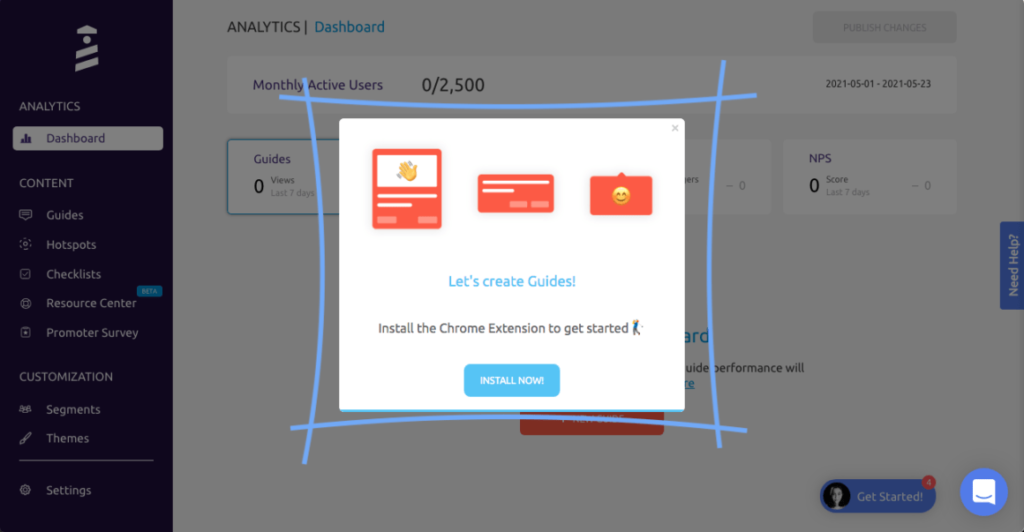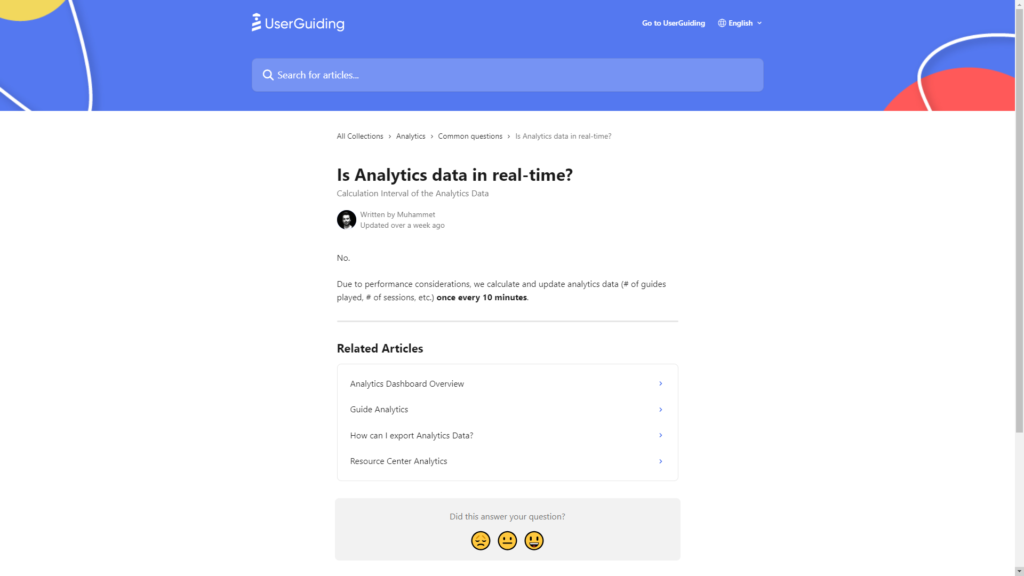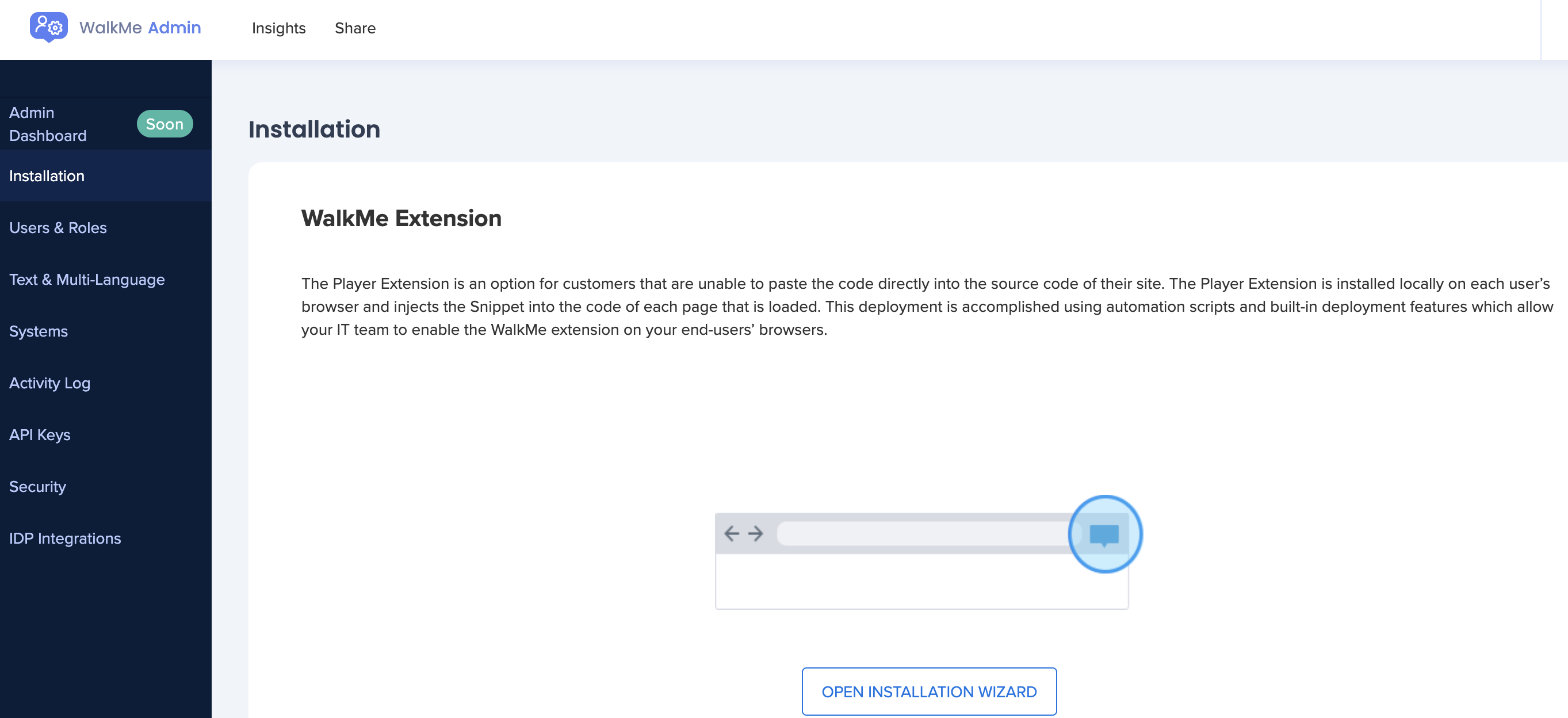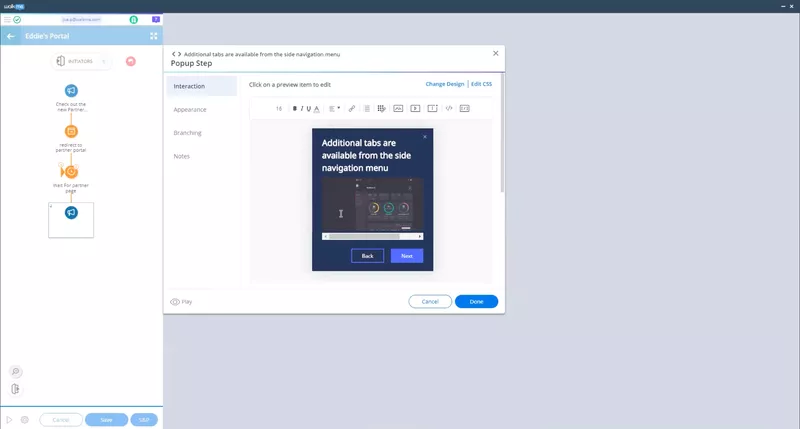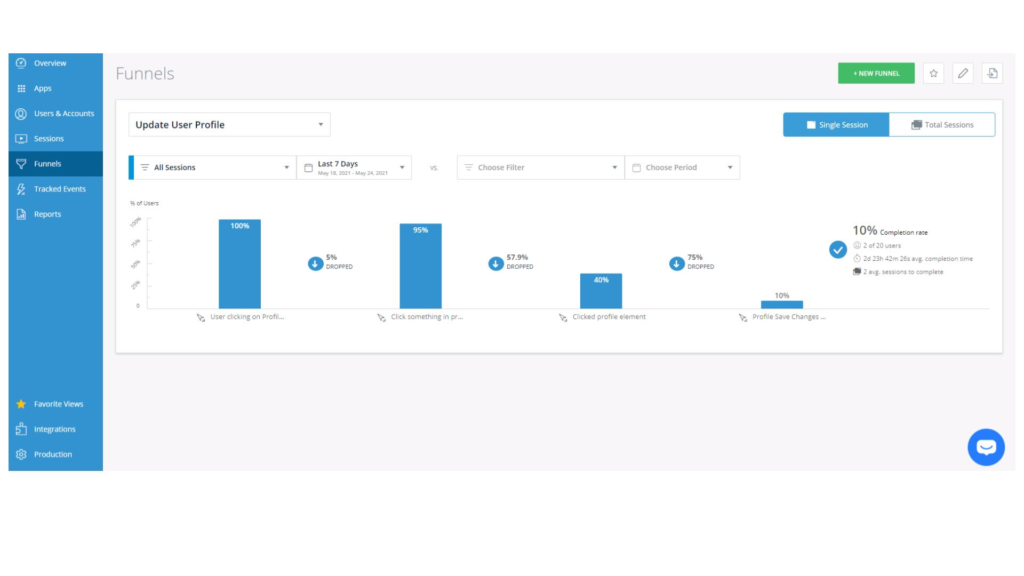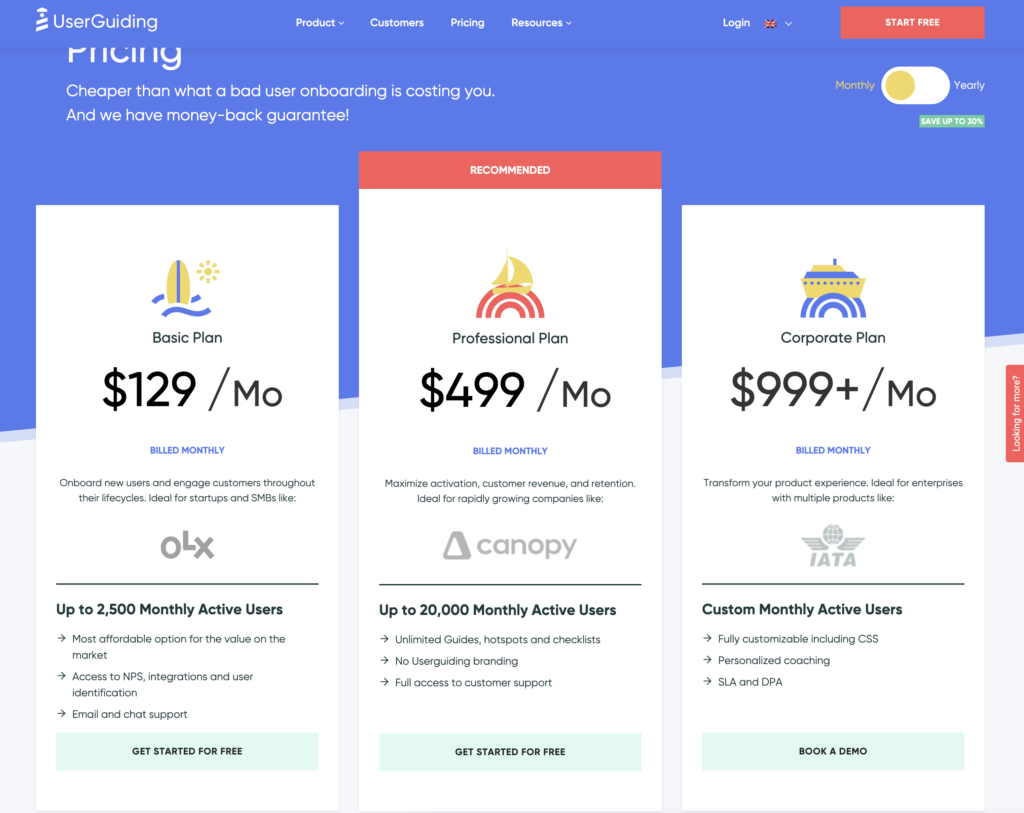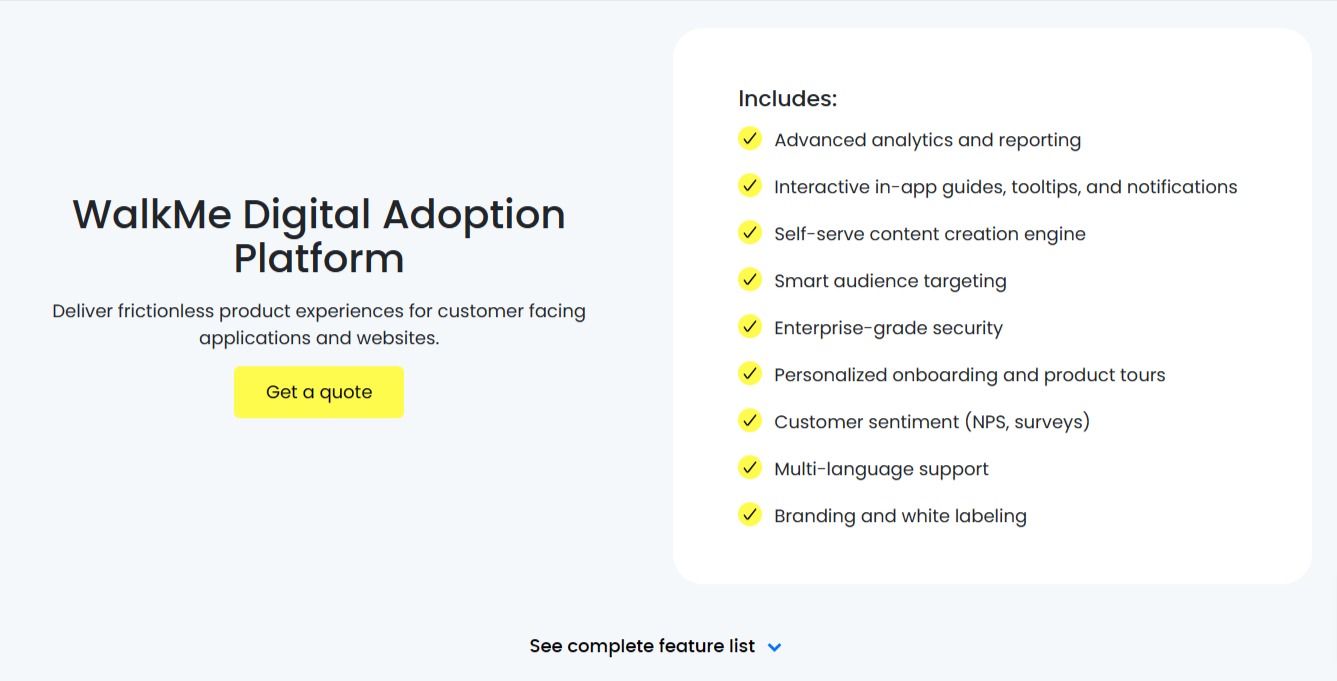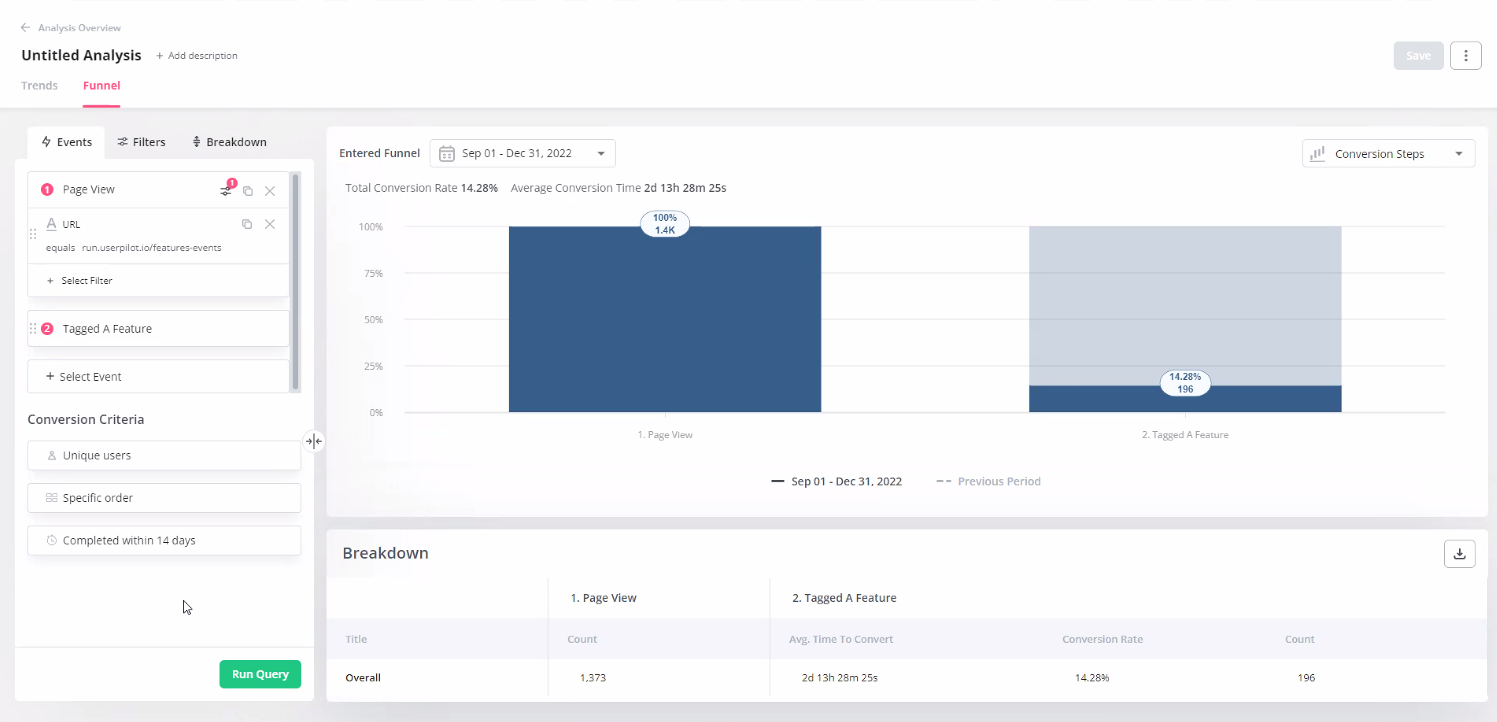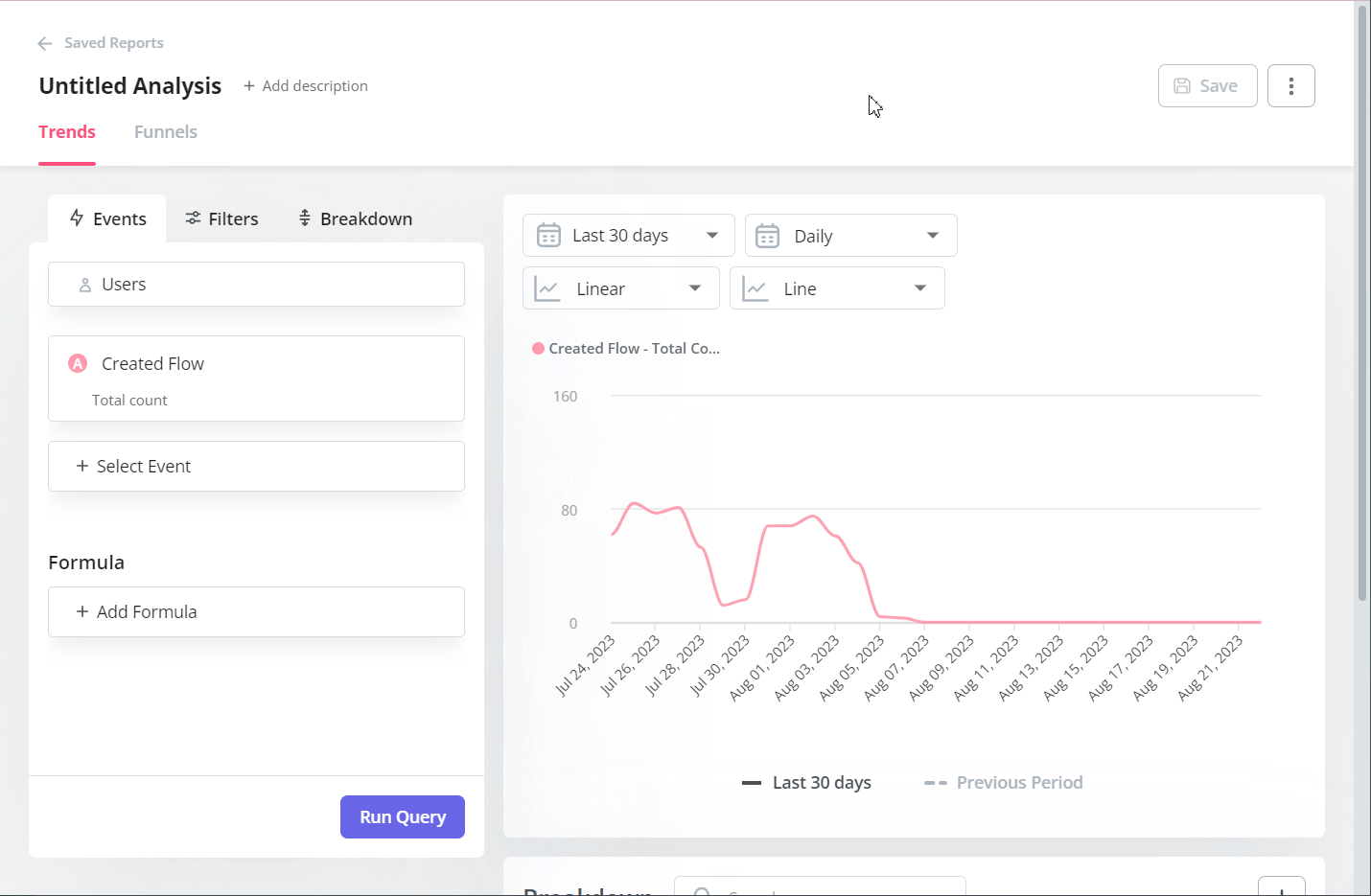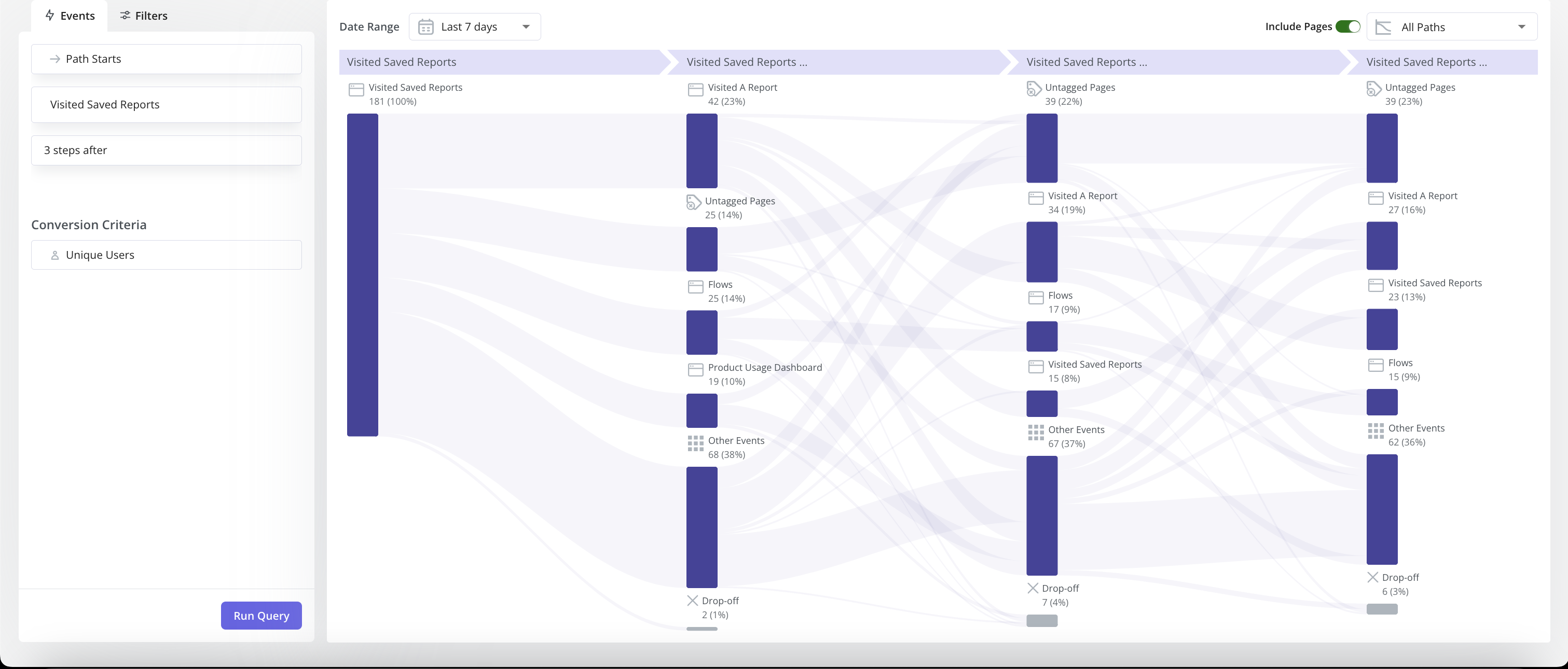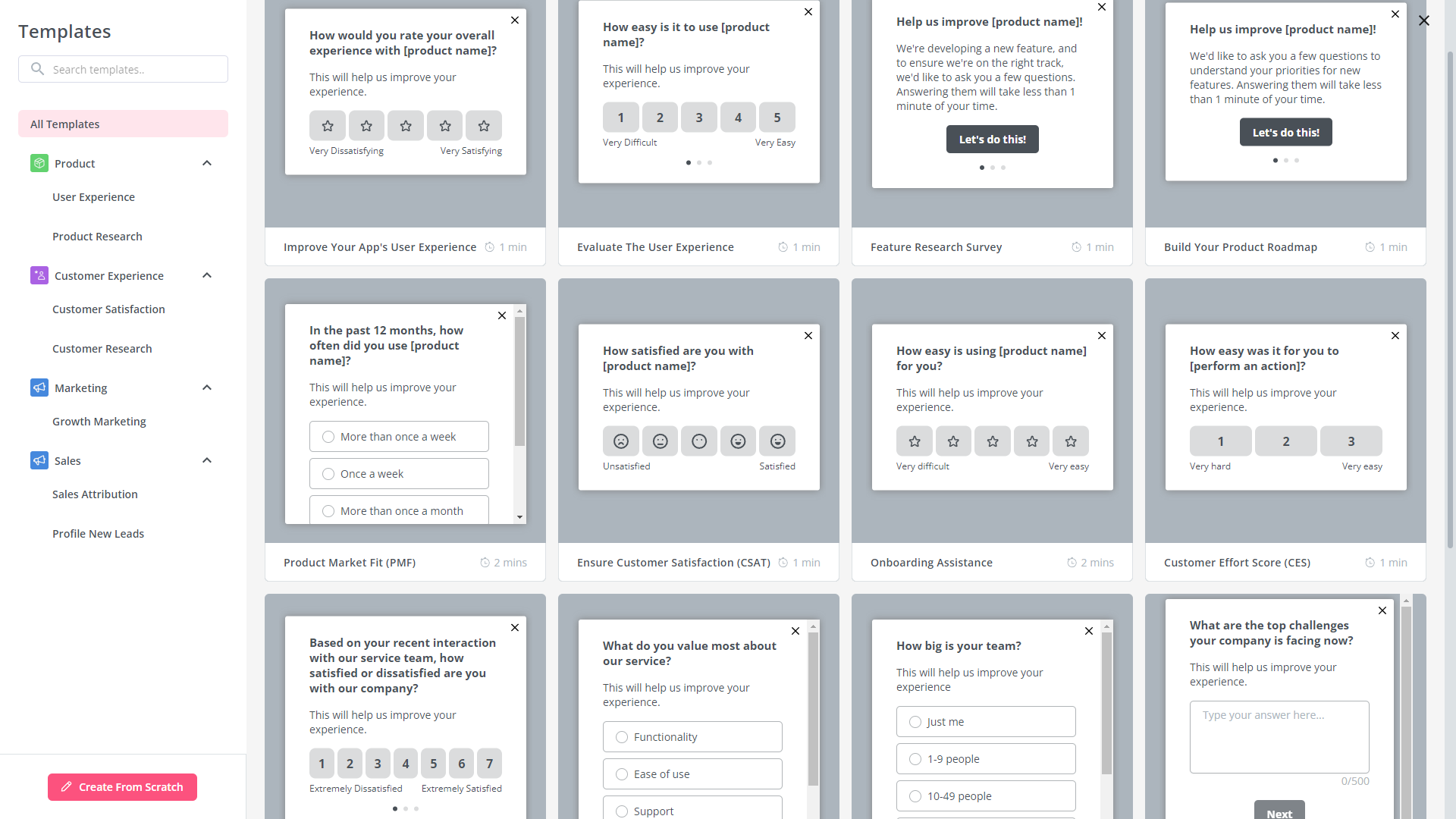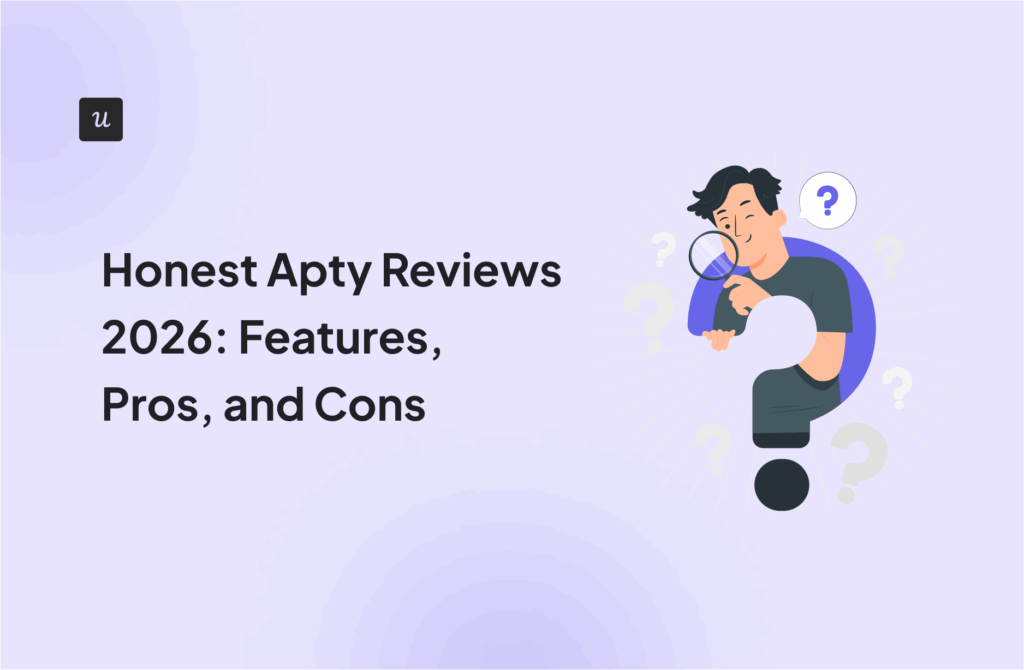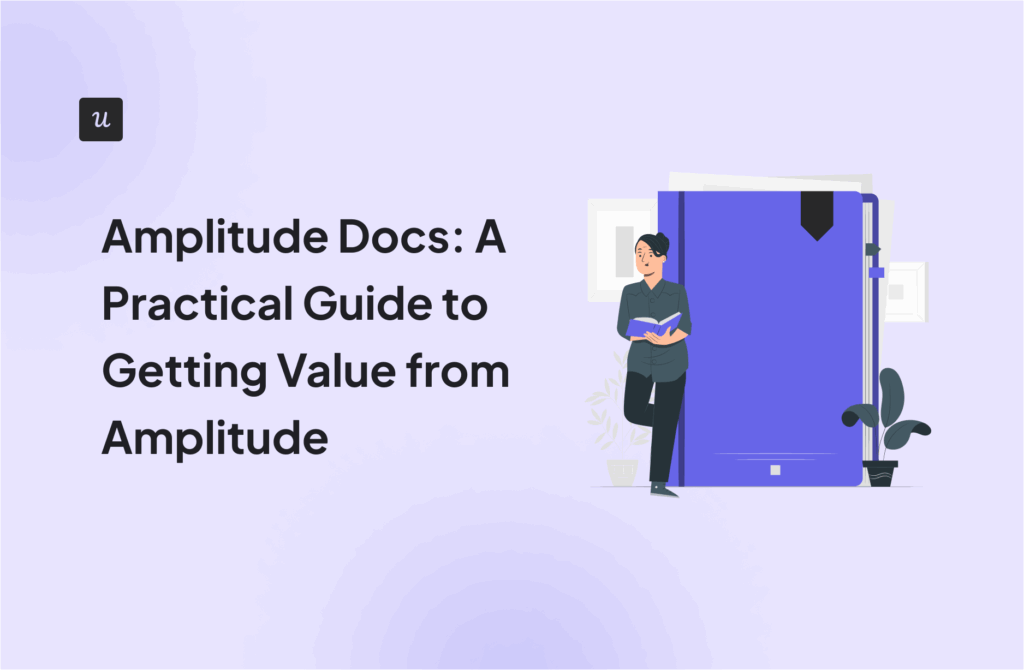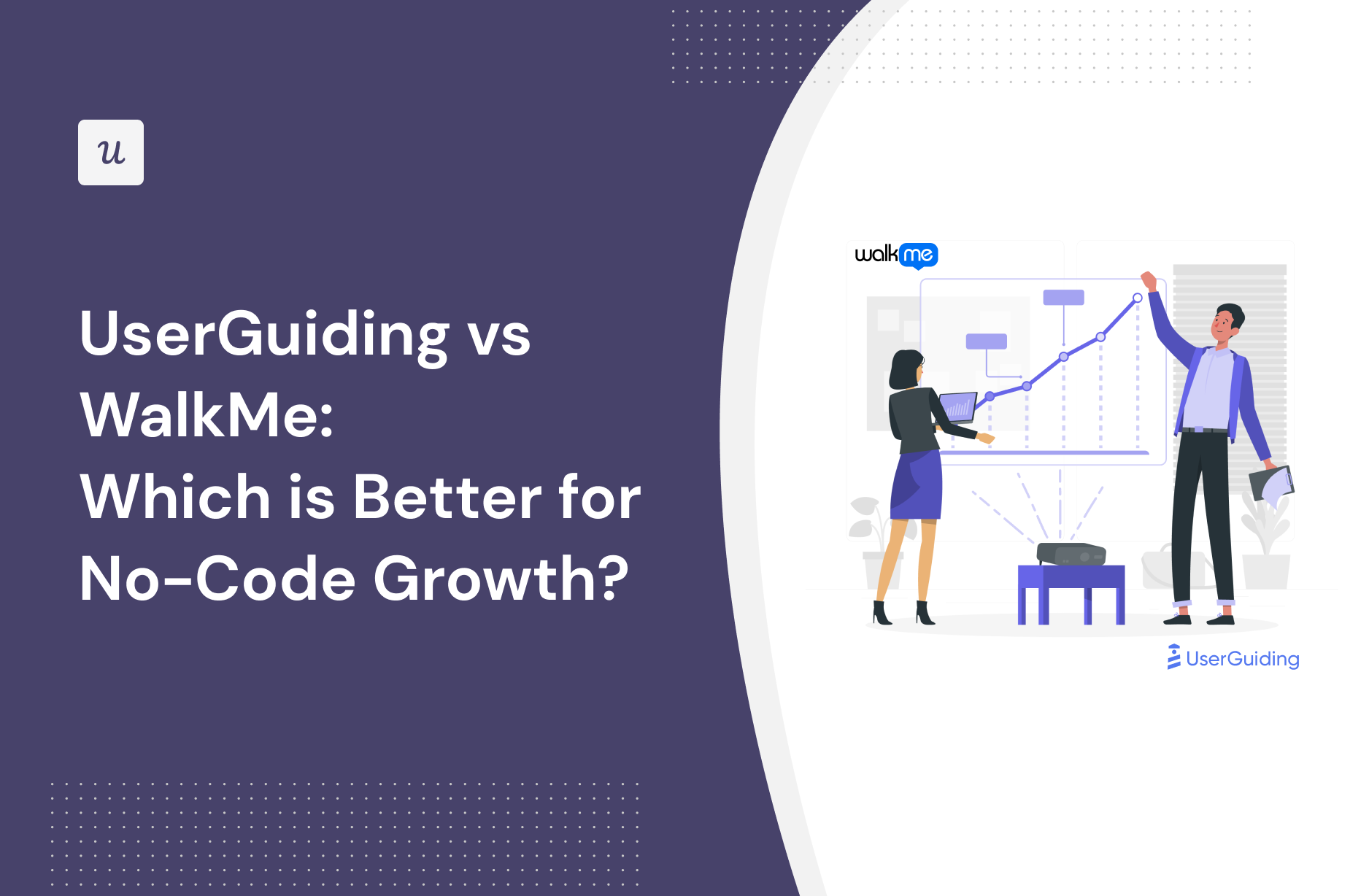
Try Userpilot Now
See Why 1,000+ Teams Choose Userpilot

What is no-code growth?
No-code growth is a method of achieving product-led growth (using your own product as a lever and revenue growth channel) without coding, using no-code tools.
It essentially allows people like product managers, product marketing managers or marketers (who may not necessarily have a background in engineering) to create e.g. in-app onboarding experiences, optimize signup and onboarding flows etc. in order to achieve higher conversion rates, user activation rates – and in the long run – drive retention.
No-code movement in general empowers non-programmers to create software elements using a graphical user interface, instead of writing code. According to no-code advocates, technology should enable and facilitate creation, not act as a barrier.
Must have features for no-code growth tools
Before deciding which no-code growth tool deserves your try, you should have a basic understanding of what features you should be looking for in “the one.”
Although the exact features you need will differ based on factors such as the size of your company, your business strategy, and your goals, here are the most crucial features you should look for:
- Truly “no code” – make sure the no code growth tool you pick really allows you to build and style robust and native-looking in-app experiences without coding. You will be surprised how many tools require the knowledge of CSS to publish decent-looking onboarding flows.
- Make sure the tool you choose has all the basic UI patterns available – e.g., checklists, modals, tooltips, banners, and hotspots. This will allow you to create all the product-led growth experiences you may need.
- Targeting the experiences to the right user segments is extremely important for your PLG plays to be successful. Make sure your no-code growth tool offers advanced segmentation capabilities, so you can build customer segments based on product usage, in-app behavior, feedback, and user persona to craft hyper-personalized messages and trigger them at the right time.
- On that note – real-time, event-based triggering is an important feature of a product growth platform that only a few solutions on the market currently offer. Being able to respond to your users’ actions in real-time can be critical to pushing them toward those precious conversion points.
- Finally, product analytics is another “must-have” that a good no-code growth platform should provide. You should be able to monitor your users’ behavior with it, the engagement with your PLG in-app experiences, and how they contribute towards improving your metrics.
- The right code-free PLG tool should also offer integrations with other tools so you can add them to your stack and get better insights on your data under one roof.
UserGuiding for no-code growth
UserGuiding is a no-code product adoption tool that lets users create in-app walkthroughs, guides, and checklists. The solution makes it possible for teams to onboard, engage, and retain users without needing coding skills to create these in-app experiences.
All in all, UserGuiding is a pretty flexible solution that can improve the onboarding process, boost user engagement, and increase customer retention.
No-code product tours in UserGuiding
UserGuiding does have the features necessary for creating basic product tours, but the no-code implementation will depend on how complex you need these onboarding flows to be. Full integration of the UserGuiding solution does require some updates to your coding.
Here are a few UserGuiding features you can use in your product tours:
- Guides: The UserGuiding Chrome extension lets you add multi-step guides to any page of your website with elements like modals, tooltips, and input fields, then preview the flow before publishing.
- Checklists: Onboarding checklists give users a sense of progress as they move through your product tours (but UserGuiding only lets you have two active at a time unless you upgrade to the Professional plan or higher).
- Hotspots: A more subtle way to highlight specific features, buttons, or elements during product tours would be to use UserGuiding’s hotspot UI pattern.
Product growth analysis in UserGuiding
Product growth is the end goal of all onboarding and adoption efforts. UserGuiding may not have the most advanced analytics capabilities (especially in comparison to competitors like Userpilot or Pendo), but it does have data filters and content engagement metrics that you can monitor.
Here are the UserGuiding features and settings you can use to extract insights from growth analytics:
- Logic Filters: UserGuiding’s and/or filters help you narrow down results (such as data or users) based on which conditions are met. This makes it possible to conduct growth analysis for different segments, cohorts, or users with similar attributes in order to spot patterns.
- Content Engagement: While UserGuiding lacks more detailed growth metrics, it does track engagement for all materials created within the platform. This lets you monitor the view count and completion rate for guides, checklists, or other UserGuiding material currently in use.
- Analytics Limitations: One of the biggest limitations of UserGuiding’s analytics capabilities is the fact that you can’t view data in real-time. All analytics are only calculated and refreshed once every 10 minutes, so you’ll need to wait for dashboards to be updated before checking metrics.
WalkMe for no-code growth
WalkMe is a digital adoption platform that can help you create frictionless experiences for your customers. The platform is built keeping the compliance, scalability, and security needs of enterprises in mind.
Using it, you can onboard customers and keep them engaged throughout their lifetime with your business. With powerful features like workflow automation and analytics, you can use it to grow your enterprise.
No-code product tours in WalkMe
Product tours are one of the most common functionalities you’d expect from a digital adoption platform. WalkMe lets you build interactive and personalized product walkthroughs with the Smart Walk-Thrus feature.
Here’s how you can build remarkable product tours with Smart Walk-Thrus:
- Provide step-by-step instructions to guide new users as they navigate your product. Each step uses tip balloons to highlight specific features or UI elements and explain how to use them or the next steps a user should take.
- Create personalized journeys by controlling the flow of product tours based on user behavior and action.
- Use ShoutOuts to communicate crucial information about different features or highlight CTAs within a product tour.
However, you’ll need some coding knowledge to create and implement Smart Walk-Thrus. If you’re looking for a platform that delivers on the promise of a no-code builder, Userpilot would be a better choice.
Product growth analysis in WalkMe
WalkMe doesn’t just offer tools to onboard and engage users and drive product adoption. You can also use the digital adoption platform to dig deeper into product usage and maximize growth.
Here’s how WalkMe facilitates product growth analysis:
- Tracked Events let you monitor user actions tied to WalkMe experiences as well as outside the platform. This feature comes in handy when you want to understand how different on-page elements/features are working and whether they’re yielding the desired results.
- The Funnels page of your WalkMe Insights account offers a closer look at how users move through a predefined sequence of events. It gives you a clear picture of conversion rates and helps you assess whether you’re on track to achieve your product adoption goals. You can also use funnel data to analyze user journeys and identify points of friction.
- You can use Session Streams and Session Playback for granular insights into user actions within a session. It can help you identify potential roadblocks to product adoption.
- Other features that come in handy include in-app survey analytics, A/B testing, and user segmentation.
UserGuiding vs WalkMe: Which one fits your budget?
Understanding the cost implications is paramount when selecting the right solution for no-code growth needs, so here’s a detailed pricing comparison of UserGuiding and WalkMe.
Pricing of UserGuiding
UserGuiding has three plans to choose from, targeted towards a range of business sizes from startup to enterprise.
Here are UserGuiding’s specific pricing details:
- Basic: Costing $129/month, the Basic plan is targeted towards startups and SMBs. The Basic plan is quite limited as it caps your account at one active survey, two active checklists, and no more than 2,500 MAUs. Features include:
- Access to user identification features.
- Integrations with Google Analytics, HubSpot, Intercom, and more.
- Email and chat support.
- Customizable theme (only one).
- Professional: The Professional plan costs almost 4x as much as the Basic tier at $499/month. That said, it significantly increases capacity to 20,000 MAUs and improves the quality of customer support you’ll receive. Features include:
- Removal of UserGuiding branding.
- Language localization.
- Full customer support access.
- Five team member seats.
- Five customizable themes.
- Unlimited guides and checklists.
- Corporate: Subscriptions on the Corporate plan start at $999/month. Of course, this higher price does come with its fair share of enterprise perks. Features include:
- Service Level Agreement (SLA) + Data Processing Agreement (DPA).
- Up to 10 active surveys.
- Custom MAU capacity based on your needs.
- Unlimited team member seats.
- Unlimited customizable themes.
All monthly plans are marked down by 30% when customers choose to bill annually.
Pricing of WalkMe
WalkMe’s pricing isn’t transparent, but it’s fully customizable based on your requirements. It offers a bunch of useful features like analytics, a self-serve content creation engine, in-app engagement creation, and more.
However, you need to get in touch with their team to find pricing details for both the customer and employee versions. Considering the platform is specifically built for enterprises, you can expect the cost to be on the higher end. You could end up spending anywhere between $9000 to $50,000 per year if you choose to use WalkMe.
Pros and cons of UserGuiding
You might need an alternative solution to UserGuiding if you fall into any of the following use cases:
- Advanced analytics: If you’re looking for a product adoption platform with full-suite native analytics then you’ll likely need to look at platforms like Userpilot or Appcues that are better suited to your needs.
- Create fully interactive product tours: While UserGuiding excels in creating in-app experiences and user guides, it may not offer the breadth of tools needed to fully support a comprehensive product adoption strategy.
- Build segments completely code-free: As segmentation features aren’t very intuitive and may require additional help from a developer.
Pros of UserGuiding
UserGuiding has quite a few benefits as a product adoption solution, particularly for early-stage SaaS companies that need an easy-to-use starter tool for their small (but growing) team of product developers or marketers. Let’s look at some of the pros that UserGuiding has to offer:
- Chrome extension – UserGuiding utilizes a no-code Chrome extension.
- Survey template gallery – UserGuiding lets you choose from six survey templates or create your own survey from scratch.
- Analytics dashboard – users can see their monthly active users (MAUs) for the month, monitor the number of views their guides are getting, and see how many interactions checklists or resource centers have had in the past week from the UserGuiding homepage.
- Custom themes – granular theme customization and color selection.
- Easy onboarding – onboarding checklist walks you through key steps, such as how to get the UserGuiding Chrome extension and create your first guide.
Cons of UserGuiding
While there are quite a few benefits to using UserGuiding, there are three significant drawbacks to note:
- Dashboard customization – you can’t edit your home dashboard or choose which analytics you want to see.
- Pricing jumps – upgrading from Basic (2,500 MAUs) to Professional (20,000 MAUs) increases your subscription cost by more than 4x.
- Manual localization – UserGuiding doesn’t have AI-powered localization, so you’ll need to manually download, translate, and upload every CSV when attempting to localize content for your product.
- HubSpot integration – the UserGuiding-HubSpot integration is only a one-way integration which limits its functionality and prevents you from setting up two-way data synchronization between both platforms.
- Limited analytics – the analytics dashboard only shows you data for onboarding materials created with UserGuiding and even those analytics are quite limited as surveys only show you total responses rather than letting you select a date range.
- Survey limit – you can only have one active survey on the Basic plan which is disappointing considering UserGuiding costs over $1,000 annually (whereas Userpilot lets you create unlimited surveys and collect up to 250 responses per month on the cheapest plan).
Pros and cons of WalkMe
WalkMe ticks a lot of the right boxes if you’re looking for a digital adoption platform that’s intuitive and scalable. However, business requirements can vary and that could mean that WalkMe might not be the right fit for you. Here are three reasons why you may need to opt for a WalkMe alternative:
- You have a low budget: WalkMe is purpose-built for enterprises and it shows in its pricing. You can expect the cost to go into thousands of dollars annually. If your business doesn’t have a huge budget, it might be better to opt for another platform.
- You want to get started quickly: If you want a platform that offers near-plug-and-play functionality, you’re better off choosing another digital adoption platform as WalkMe has a moderate learning curve.
- You don’t want to work with CSS/HTML: Even though WalkMe is marketed as a no-code/low-code platform, there are some aspects where you’ll need CSS/HTML knowledge for customizations. If you want a fully no-code solution, you’re better off opting for an alternative.
Pros of WalkMe
WalkMe is among the most popular platforms out there for digital adoption, especially for enterprises. It’s got a range of useful features that businesses can leverage to create in-app engagements, track user behavior, and retain customers, among other things. Here are the pros of using WalkMe:
- Multiple in-app engagements: Offers a bunch of in-app engagement options, including product tours, tooltips, help widgets, onboarding checklists, and more. Using them well can help you engage your customers.
- User-friendliness: The platform is quite user-friendly in terms of creating in-app engagements. And while it does have a moderate learning curve as a whole, it becomes easy to use once you get the hang of it.
- Lots of analytics: WalkMe provides in-depth analytics on a range of things like in-app engagements and forms to help you understand the impact that they’re creating. This helps you optimize your strategies for better results.
- Workflow automation: Workflow automation features like onboarding automation stand out as they enable you to automate a series of steps and processes like clicking buttons to make your customer experience better.
- Community: WalkMe offers a strong community of experts and partners who can help you whenever you get stuck.
Cons of WalkMe
While WalkMe has a bunch of good things to offer that make it one of the leading digital adoption platforms out there, it does have a few drawbacks that prevent you from unlocking its full potential. Let’s take a look at some of the cons of this platform:
- Coding knowledge: Even though WalkMe is no-code/low-code for most of its functions, you’ll need to know HTML or CSS to make the most out of the platform.
- Challenging on complex sites: The process of implementing WalkMe on your website depends on the complexity of your site. You might find it challenging to ensure that your content behaves the way it should if you’ve got a complicated website.
- Focused on employees: WalkMe’s primary use case lies in digital adoption for employees, even though it has a specific plan for customers. However, this makes it slightly weaker compared to other platforms that have been dedicatedly built for customers.
Userpilot – A better alternative for no-code growth
Userpilot is a product growth platform that drives user activation, feature adoption, and expansion revenue. It also helps product teams collect user feedback, streamline onboarding, and gather actionable insights from analytics.
With Userpilot, you’ll be able to track both product usage and user behavior to get a holistic view of how customers use your product — which will guide future development, improve the user experience, and inform your growth efforts.
No-code product tours in Userpilot
Product tours are an effective way to show new users what a product can do and reduce the time-to-value (TTV) for them. Userpilot lets you build advanced product tours, set contextual triggers, and target specific audiences, all without writing a single line of code.
Here are the Userpilot features that you can use to build a product tour for your users:
- Flow builder: Userpilot’s no-code flow builder has a variety of UI patterns to choose from, such as modals, slideouts, tooltips, and driven actions. All UI patterns are available for use regardless of which Userpilot plan you’re on. All you need to do is install the Chrome extension.
- Contextual triggers: Userpilot lets you set triggers for your flows to ensure that they appear at the most contextual moments. Flows could be triggered when users land on a specific page or when a tracked event occurs. There are also manual triggering options that you can tinker with.
- Audience targeting: Userpilot’s audience targeting setting lets you set the conditions needed for a flow to show up for a specific user. You can use these settings to create flows that target a specific segment or exclude certain users from seeing a flow if certain conditions are met.
Product growth analysis in Userpilot
Tracking growth analytics is essential to gauge the overall trajectory of your product. Userpilot lets you track the completion rates for specific funnels, measure the number of users completing certain goals, and survey your customers to identify the issue whenever growth metrics trend downward. Here’s how Userpilot analytics can help you measure product growth:
- Dashboards: An easy way to keep track of your key product performance and user behavior metrics at a glance, without any technical setup required. There are 4 main dashboards available for your product growth analysis: Product usage, New users activation, Core feature engagement, and User retention.
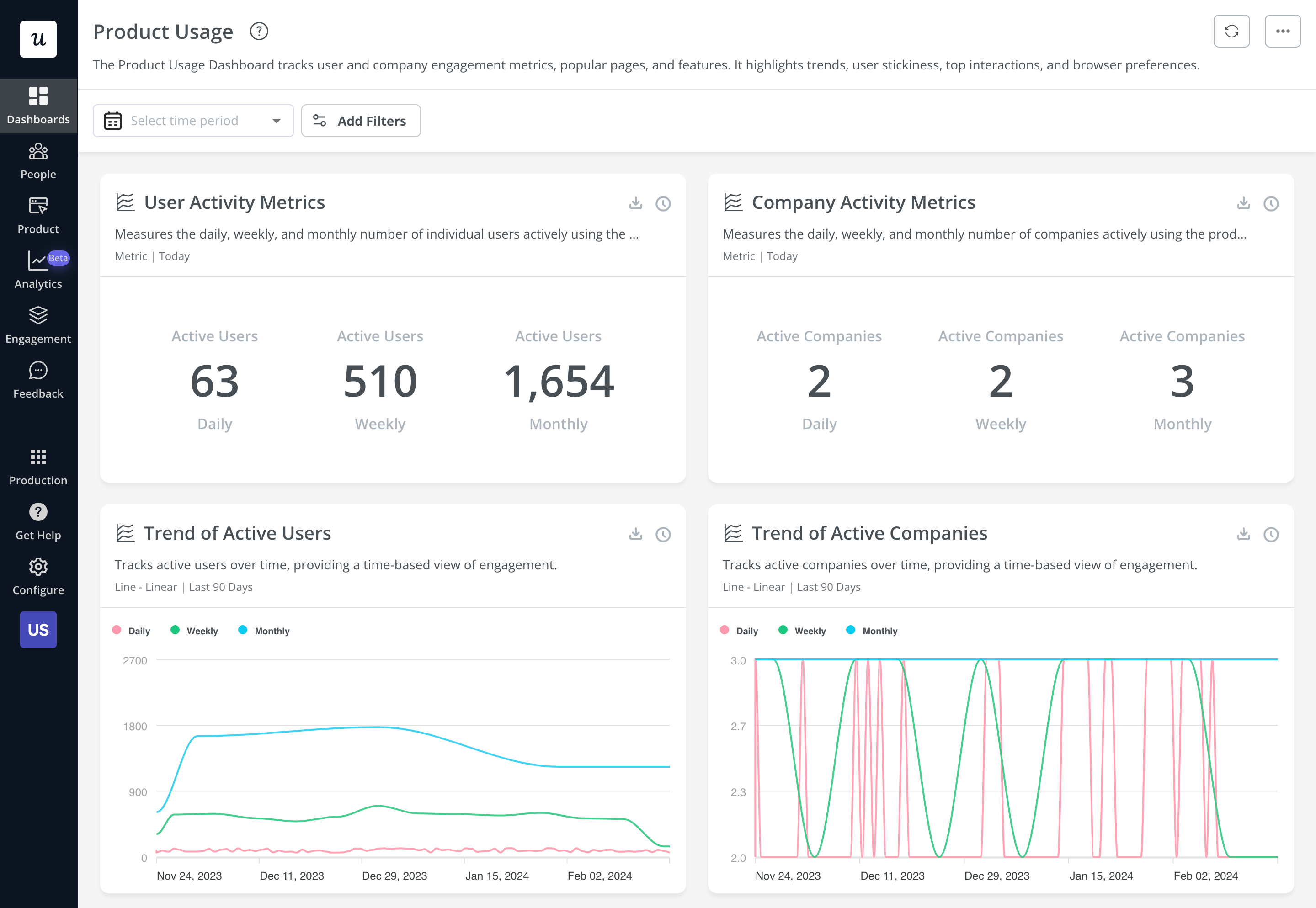
- Funnels: Userpilot’s funnel reports show you the number of users that enter a funnel and the percentage that completes each step. These visual charts can help you identify the roadblocks that are hindering user activation, causing churn, or sabotaging the efficacy of upsells.
- Trends: Trend reports let you see how specific product changes impact retention metrics and monitor changes in active user counts over certain time periods. You can also create custom metrics, track events, or use the breakdown tab to perform a correlative retention analysis.
- Paths: It provides a detailed understanding of customer actions through a sequence of steps and helps pinpoint areas where customers tend to drop off – which may indicate frictions that hinder product growth.
- Surveys: Userpilot’s survey builder has 14 survey templates that can help you find the root cause behind slowing growth rates. There are quantitative templates for collecting satisfaction metrics and qualitative surveys you can use to get user feedback on specific product areas or features.
Pricing of Userpilot
Userpilot offers flexible pricing based on your monthly active users (MAUs). Plans start at $299 per month for smaller teams and scale as your user base grows.
Below are the pricing tiers you can choose from:
- The Starter plan begins at $299/month (billed annually) for up to 2,000 monthly active users. It includes in-app user engagement, usage trend analysis, NPS surveys, and essential product analytics—ideal for mid-market SaaS teams getting started.
- The Growth plan offers custom pricing and adds advanced analytics, retroactive event auto-capture, in-app surveys, session replay, and more. It’s the most popular choice for growing teams that need deeper insights and scale.
- The Enterprise plan offers custom pricing and includes everything in Growth, plus bulk data handling, custom roles and permissions, SOC 2 Type 2 compliance, and enterprise-level support.

What do users say about Userpilot?
Most users laud Userpilot for its versatile feature set, ease of use, and responsive support team:
I recently had the pleasure of using Userpilot, and I must say it exceeded all my expectations. As a product manager, I’m always on the lookout for tools that can enhance user onboarding and improve overall user experience. Userpilot not only delivered on these fronts but also went above and beyond with its impressive new features, unparalleled ease of use, and truly exceptional customer support.
What truly sets Userpilot apart is its outstanding customer support. Throughout my journey with Userpilot, the support team has been responsive, knowledgeable, and genuinely dedicated to helping me succeed. Whenever I had a question or encountered an issue, their support team was always there to assist promptly, going above and beyond to ensure my concerns were addressed effectively.
Source: G2.
Of course, other users are also kind enough to share constructive criticism regarding specific features like event tracking filters:
“The filtration while analyzing specific events is a little confusing. Understanding of custom properties and data management configuration could have been more organised.”
Source: G2.
Conclusion
This is the end of our thorough comparison between UserGuiding and WalkMe. You should be able to make a confident decision by now. If you’re looking for a solid tool for no-code growth that promises great value for money, give Userpilot a go. Book a demo today.

